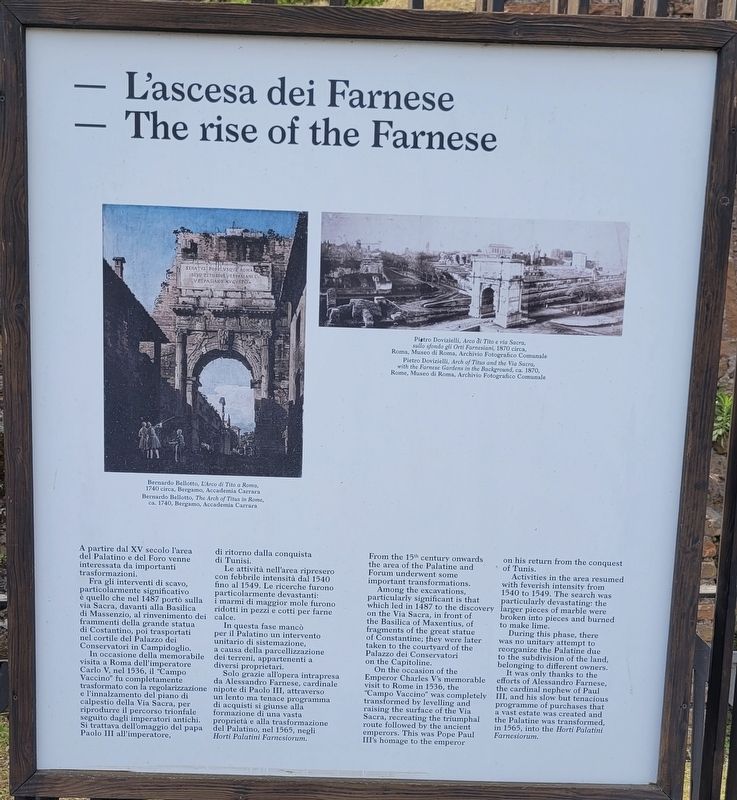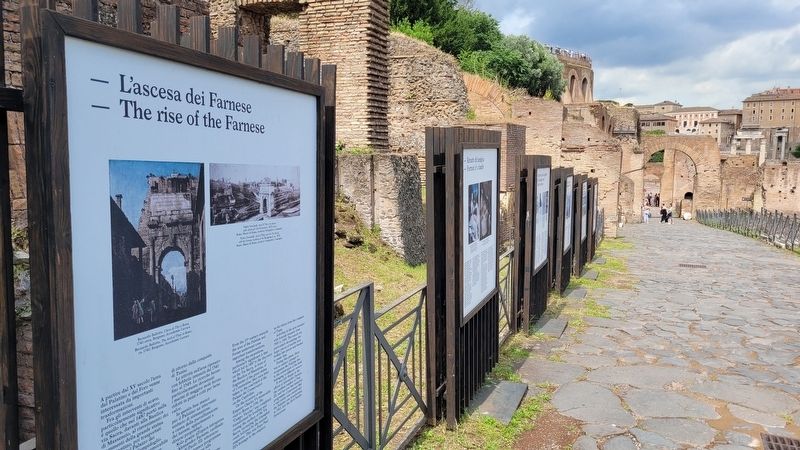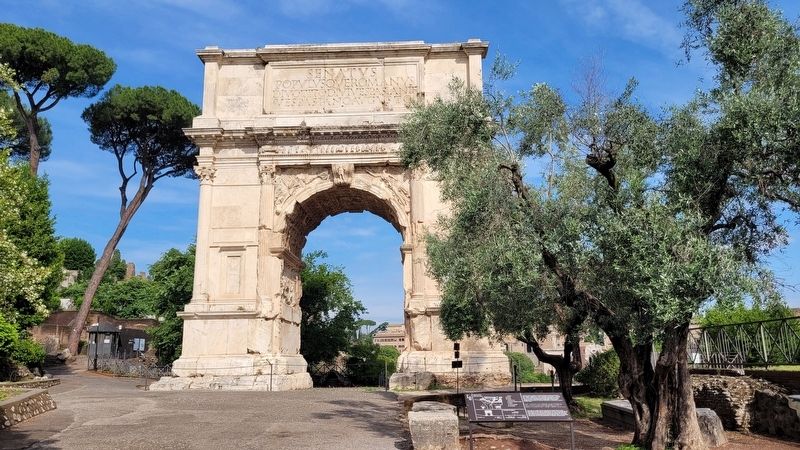Rione X Campitelli in Roma in Città metropolitana di Roma Capitale, Latium, Rome, Italy — Central Italy (Tyrrhenian Coast)
L'ascesa dei Farnese / The rise of the Farnese
Fra gli interventi di scavo, particolarmente significativo è quello che nel 1487 portò sulla via Sacra, davanti alla Basilica di Massenzio, al rinvenimento dei frammenti della grande statua di Costantino, poi trasportati nel cortile del Palazzo dei Conservatori in Campidoglio.
In occasione della memorabile visita a Roma dell'imperatore Carlo V, nel 1536, il "Campo Vaccino" fu completamente trasformato con la regolarizzazione e l'innalzamento del piano di calpestio della Via Sacra, per riprodurre il percorso trionfale seguito dagli imperatori antichi. Si trattava dell'omaggio del papa Paolo III all'imperatore, di ritorno dalla conquista di Tunisi.
Le attività nell'area ripresero con febbrile intensità dal 1540 fino al 1549. Le ricerche furono particolarmente devastanti: i marmi di maggior mole furono ridotti in pezzi e cotti per farne calce.
In questa fase mancò per il Palatino un intervento unitario di sistemazione, a causa della parcellizzazione dei terreni, appartenenti a diversi proprietari.
Solo grazie all'opera intrapresa da Alessandro Farnese, cardinale nipote di Paolo III, attraverso un lento ma tenace programma di acquisti si giunse alla formazione di una vasta proprietà e alla trasformazione del Palatino, nel 1565, negli Horti Palatini Farnesiorum.
Didascalie
Bernardo Bellotto, L'Arco di Tito a Roma, 1740 circa, Bergamo, Accademia Carrara
Pietro Dovizielli, Arco di Tito e via Sacra, sullo sfondo gli Orti Farnesiani, 1870 circa, Roma, Museo di Roma, Archivio Fotografico Comunale
From the 15th century onwards the area of the Palatine and Forum underwent some important transformations.
Among the excavations, particularly significant is that which led in 1487 to the discovery on the Via Sacra, in front of the Basilica of Maxentius, of fragments of the great statue of Constantine; they were later taken to the courtyard of the Palazzo dei Conservatori on the Capitoline.
On the occasion of the Emperor Charles V's memorable visit to Rome in 1536, the "Campo Vaccino" was completely transformed by levelling and raising the surface of the Via Sacra, recreating the triumphal route followed by the ancient emperors. This was Pope Paul III's homage to the emperor on his return from the conquest of Tunis.
Activities in the area resumed with
feverish intensity from 1540 to 1549. The search was particularly devastating: the larger pieces of marble were broken into pieces and burned to make lime.
During this phase, there was no unitary attempt to reorganize the Palatine due to the subdivision of the land, belonging to different owners.
It was only thanks to the efforts of Alessandro Farnese, the cardinal nephew of Paul III, and his slow but tenacious programme of purchases that a vast estate was created and the Palatine was transformed, in 1565, into the Horti Palatini Farnesiorum.
Captions
Bernardo Bellotto, The Arch of Titus in Rome, ca. 1740, Bergamo, Accademia Carrara
Pietro Dovizielli, Arch of Titus and the Via Sacra, with the Farnese Gardens in the Background, ca. 1870, Rome, Museo di Roma, Archivio Fotografico Comunale
Topics. This historical marker is listed in these topic lists: Anthropology & Archaeology • Architecture • Churches & Religion • Horticulture & Forestry. A significant historical year for this entry is 1487.
Location. 41° 53.44′ N, 12° 29.275′ E. Marker is in Roma, Lazio (Latium, Rome), in Città metropolitana di Roma Capitale. It is in Rione X Campitelli. Marker is at the intersection of Via Nova and Via Sacra on Via Nova. The marker is located west of the Arch of Titus in the Roman Forum. Touch for map. Marker is in this post office area: Roma, Lazio 00186, Italy. Touch for directions.
Other nearby markers. At least 8 other markers are within walking distance of this marker. Ritratto di famiglia / Portrait of a family (here, next to this marker); Il recinto con il suo portale / The boundary wall and its entrance (here, next to this marker); Il Teatro di ingresso / The entrance Theatre (a few steps from this marker); Prima dei Farnese / Before the Farnese (a few steps from this marker); Il Casino del Belvedere e il giardino segreto / The Belvedere Lodge and the Secret Garden (a few steps from this marker); Via Nova (a few steps from this marker); La riscoperta dell'antico: gli architetti / The rediscovery of antiquity: architects (a few steps from this marker); La costruzione degli Orti: il giardino del Duca di Parma (within shouting distance of this marker). Touch for a list and map of all markers in Roma.
More about this marker. The marker is located in the Parco Archeologico del Colosseo (Roman Forum Archaeological Park) and it does require an entry fee to visit.
Also see . . .
1. Parco Archeologico del Colosseo. Roma Turismo (Submitted on August 13, 2023, by James Hulse of Medina, Texas.)
2. Farnese Gardens. Wikipedia (Submitted on August 13, 2023, by James Hulse of Medina, Texas.)
Credits. This page was last revised on August 13, 2023. It was originally submitted on August 11, 2023, by James Hulse of Medina, Texas. This page has been viewed 63 times since then and 15 times this year. Photos: 1, 2, 3. submitted on August 13, 2023, by James Hulse of Medina, Texas.


